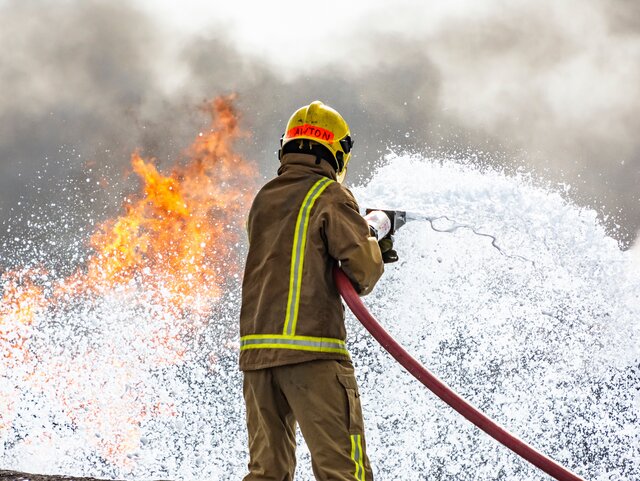FRIC Risk Alert: Defective Hydrants
1 Intended Audience
All Member Representatives; Hydrant maintenance Lead Officers;
2 Summary
At the beginning of July 2024, the NFCC issued a letter to all Chief Fire Officers, updating them on progress by some water companies (including Southern Water and Thames Water) to inspect, repair or replace Aquagas Series 19 hydrants, which had been identified as presenting a potential risk to users if operated under pressure. A copy of the letter is attached for ease of location together with copies of the original defect notices issued by the two English water companies involved, referring to the issue.
Both companies have advised that this type of hydrant should no longer be used until it can be checked or replaced, and some have placed “do not use” notices in hydrant pits as an additional warning. This has obviously caused some concern for those Members with a significant number of these hydrant in situ. There are obvious conflicts between the statutory duty to ensure adequate water for firefighting, and the duty of care to employees for their safety and wellbeing. As a result, we have been asked what FRIC’s view would be if Members continued to use these installations against the advice of the water companies where an operational imperative required it, and no alternative water sources were available.
As Managers, Thomas Miller is not permitted to give advice, especially legal advice, to FRIC’s Members, as it is not qualified to do so. We recommend that if Members wish to understand where the conflict between the statutory duty to provide water and the duty to ensure the safety of employees might sit legally, they should speak to their own legal advisors. We would of course welcome sight of any such advice should it become available.
That said, FRIC has considered how such a situation might impact on its approach to dealing with any claims that arise as a result of a defecting hydrant incident. Under normal circumstances, an injury to an employee involving a defective hydrant would be considered by FRIC in the normal way, and depending on the circumstances, FRIC might look to subrogate the claim to the water company that installed the hydrant on the grounds it was defective or not fit for purpose, thus limiting its losses, and potentially that of the member. It is our view however, that given the instruction to stop using these hydrants that has been issued, should an injury occur, the subrogation option would not be available, leaving FRIC to deal with the claim itself. In the event that liability is accepted, FRIC would meet the claim, subject to any deductible payable by the member. It is likely that a court would deem the FRA to have been negligent in acting against the advice of the water company, thus triggering the protection. For the avoidance of doubt, it is our belief that any injury to a third party user, whether officially authorised by the water company or not, would not result in a successful claim against the FRA.
We are unsure what mitigation the statutory duty to provide water for firefighting might afford in the event of a claim, but we are not confident that it would apply in a civil case for injury compensation in any event. It may have a greater impact should a criminal case ensue but a formal legal view would be required to determine how a court might view this scenario.
It is not for FRIC or the Managers to stipulate how individual FRAs decide to respond to this issue. If it is intended to continue to use the identified hydrants where no viable alternative is identified however, we would expect consideration of a series of risk reduction measures to be implemented, including:
- Risk alerts providing warning of the potential hazards from the issue to be circulated to operational crews.
- Reinforcement of operational procedures relating to the safe method of use of hydrants to avoid the risk of impact with the operator, with regular reminders and interventions by crew managers.
- Information regarding additional procedures to be adopted when it is decided to use one of the affective hydrants to be circulated to crews.
- A process for enhanced inspection and identification of these hydrants and a risk-based approach to decisions on future usage.
- Enhanced arrangements for crews to report findings following inspection or usage of hydrants.
- Regular liaison with the Water Companies on progress with replacement/repair.
In summary, FRIC will continue to provide protection to its Members where they take an informed operational decision to access one of the affective hydrants and an injury to an employee arises. Members should be aware however that they will likely incur the full deductible applicable to the claim as no recourse to third parties, other than any potential contributory negligence, will be possible.
Actions Required
|
3 Impacted FRIC Guidance
None
4 Reference Information and Further Reading
| Safety sheets and NFCC advice attached. | |
Members may wish to seek a formal legal opinion on the impact of the conflict in duties of claims and criminal cases. | |
None | |
Please note this information is for members only and should not be shared outside of FRIC and its member FRAs without prior approval from the Mutual Manager. |
Document Audit Information
Accountable Group/Body: FRIC Board
Authorised by: Mutual Manager
Direct enquiries to: info@fric.org.uk or sue.nugent@fric.org.uk
Date Implemented: 12 September 2024, reviewed 6 February 2025
Review by: Redvers Cunningham; Sophia Reed, Sue Nugent; Nic Warmink
Validation & Checking: N/A
Date issued: 6 February 2025
- Date
- 25/02/2025


